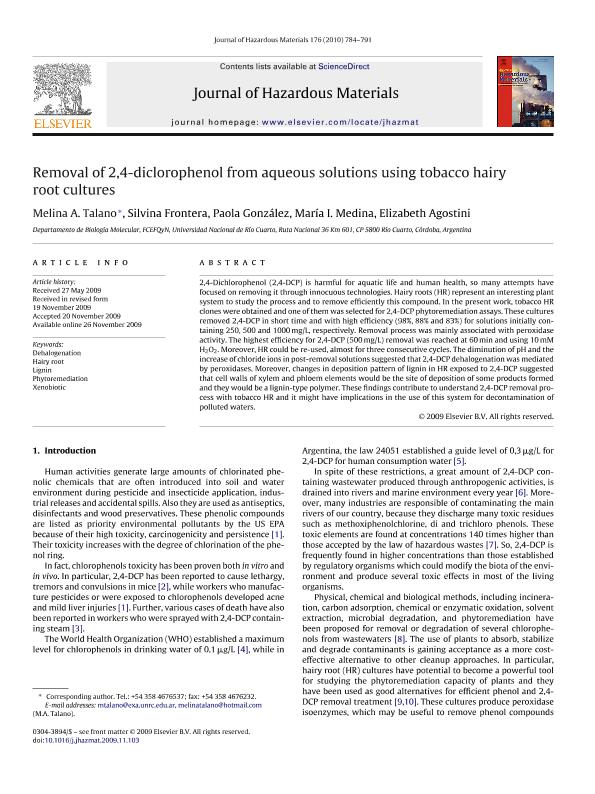Mostrar el registro sencillo del ítem
dc.contributor.author
Talano, Melina Andrea

dc.contributor.author
Frontera Perez, Silvina de Lourdes

dc.contributor.author
González, Paola Solange

dc.contributor.author
Medina, María I.
dc.contributor.author
Agostini, Elizabeth

dc.date.available
2020-07-21T15:16:11Z
dc.date.issued
2010-04
dc.identifier.citation
Talano, Melina Andrea; Frontera Perez, Silvina de Lourdes; González, Paola Solange; Medina, María I.; Agostini, Elizabeth; Removal of 2,4-diclorophenol from aqueous solutions using tobacco hairy root cultures; Elsevier Science; Journal of Hazardous Materials; 176; 1-3; 4-2010; 784-791
dc.identifier.issn
0304-3894
dc.identifier.uri
http://hdl.handle.net/11336/109726
dc.description.abstract
2,4-Dichlorophenol (2,4-DCP) is harmful for aquatic life and human health, so many attempts have focused on removing it through innocuous technologies. Hairy roots (HR) represent an interesting plant system to study the process and to remove efficiently this compound. In the present work, tobacco HR clones were obtained and one of them was selected for 2,4-DCP phytoremediation assays. These cultures removed 2,4-DCP in short time and with high efficiency (98%, 88% and 83%) for solutions initially containing 250, 500 and 1000 mg/L, respectively. Removal process was mainly associated with peroxidase activity. The highest efficiency for 2,4-DCP (500 mg/L) removal was reached at 60 min and using 10mM H2O2. Moreover, HR could be re-used, almost for three consecutive cycles. The diminution of pH and the increase of chloride ions in post-removal solutions suggested that 2,4-DCP dehalogenation was mediated by peroxidases. Moreover, changes in deposition pattern of lignin in HR exposed to 2,4-DCP suggested that cell walls of xylem and phloem elements would be the site of deposition of some products formed and they would be a lignin-type polymer. These findings contribute to understand 2,4-DCP removal process with tobacco HR and it might have implications in the use of this system for decontamination of polluted waters. increase of chloride ions in post-removal solutions suggested that 2,4-DCP dehalogenation was mediated by peroxidases. Moreover, changes in deposition pattern of lignin in HR exposed to 2,4-DCP suggested that cell walls of xylem and phloem elements would be the site of deposition of some products formed and they would be a lignin-type polymer. These findings contribute to understand 2,4-DCP removal process with tobacco HR and it might have implications in the use of this system for decontamination of polluted waters. 2O2. Moreover, HR could be re-used, almost for three consecutive cycles. The diminution of pH and the increase of chloride ions in post-removal solutions suggested that 2,4-DCP dehalogenation was mediated by peroxidases. Moreover, changes in deposition pattern of lignin in HR exposed to 2,4-DCP suggested that cell walls of xylem and phloem elements would be the site of deposition of some products formed and they would be a lignin-type polymer. These findings contribute to understand 2,4-DCP removal process with tobacco HR and it might have implications in the use of this system for decontamination of polluted waters.
dc.format
application/pdf
dc.language.iso
eng
dc.publisher
Elsevier Science

dc.rights
info:eu-repo/semantics/openAccess
dc.rights.uri
https://creativecommons.org/licenses/by-nc-sa/2.5/ar/
dc.subject
DESHALOGENATION
dc.subject
HAIRY ROOT
dc.subject
LIGNIN
dc.subject
PHYTOREMEDIATION
dc.subject.classification
Bioremediación, Diagnóstico Biotecnológico en Gestión Medioambiental

dc.subject.classification
Biotecnología del Medio Ambiente

dc.subject.classification
INGENIERÍAS Y TECNOLOGÍAS

dc.title
Removal of 2,4-diclorophenol from aqueous solutions using tobacco hairy root cultures
dc.type
info:eu-repo/semantics/article
dc.type
info:ar-repo/semantics/artículo
dc.type
info:eu-repo/semantics/publishedVersion
dc.date.updated
2020-07-20T20:17:59Z
dc.journal.volume
176
dc.journal.number
1-3
dc.journal.pagination
784-791
dc.journal.pais
Países Bajos

dc.journal.ciudad
Amsterdam
dc.description.fil
Fil: Talano, Melina Andrea. Universidad Nacional de Río Cuarto. Facultad de Ciencias Exactas Fisicoquímicas y Naturales. Departamento de Biología Molecular; Argentina. Consejo Nacional de Investigaciones Científicas y Técnicas; Argentina
dc.description.fil
Fil: Frontera Perez, Silvina de Lourdes. Universidad Nacional de Río Cuarto. Facultad de Ciencias Exactas Fisicoquímicas y Naturales. Departamento de Biología Molecular; Argentina
dc.description.fil
Fil: González, Paola Solange. Universidad Nacional de Río Cuarto. Facultad de Ciencias Exactas Fisicoquímicas y Naturales. Departamento de Biología Molecular; Argentina. Consejo Nacional de Investigaciones Científicas y Técnicas; Argentina
dc.description.fil
Fil: Medina, María I.. Universidad Nacional de Río Cuarto. Facultad de Ciencias Exactas Fisicoquímicas y Naturales. Departamento de Biología Molecular; Argentina
dc.description.fil
Fil: Agostini, Elizabeth. Universidad Nacional de Rio Cuarto. Facultad de Cs.exactas Fisicoquimicas y Naturales. Instituto de Biotecnologia Ambiental y Salud. - Consejo Nacional de Investigaciones Cientificas y Tecnicas. Centro Cientifico Tecnologico Conicet - Cordoba. Instituto de Biotecnologia Ambiental y Salud.; Argentina
dc.journal.title
Journal of Hazardous Materials

dc.relation.alternativeid
info:eu-repo/semantics/altIdentifier/url/https://www.sciencedirect.com/science/article/abs/pii/S0304389409019037
dc.relation.alternativeid
info:eu-repo/semantics/altIdentifier/doi/http://dx.doi.org/10.1016/j.jhazmat.2009.11.103
Archivos asociados
